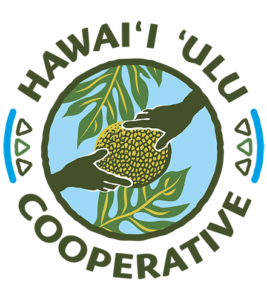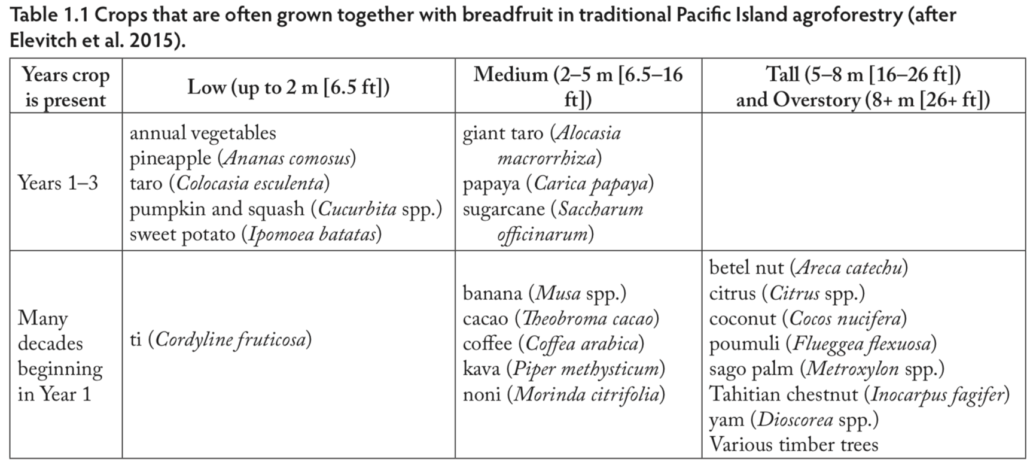Co-crops & Interplanting
Co-crops in a breadfruit-centric agroforestry system are defined as: all other crops which are planted within the system, in the upper canopy, the mid-story, and the understory/ground cover. Co-crops provide the short-term benefit of generating income before the breadfruit have begun bearing. Different species also create the long-term benefit of biological diversity, living mulch materials, and diversified income. Interplanting co-crops in a successional planting design creates different stages of crop yields for the changing maturation of the entire system. Understory co-crops will produce more in the early years of these systems – and once the upper canopy level develops, we should expect a drop in sun-loving crop yields, balanced out by the production of overstory tree crops.
Benefits of successional planting
Income Diversity – Given that breadfruit doesn’t bear a commercial crop for about 5 years, income from other sources in the short term is beneficial to a farm. In between the breadfruit trees, and in between the rows of breadfruit trees, there is a large area of unshaded space in the early years, and partially shaded space in perpetuity. This in-row and between-row acreage can be used to drive revenue with sun-loving crops such as kalo/taro and other vegetables in the near term, and shade-tolerant crops such as cacao and māmaki in the long-term.
Biodiversity – Crop diversity generally increases biodiversity, if management caters to soil biology and above-ground insect diversity. A complex ecosystem can often reduce pest pressure: example, bats provide up to $53 billion worth of ecosystem services to agriculture, every year.
Management synergy – At the very least, managing co-crops creates an intersection point for observation: if a farmer attends to a row of squash next to ‘ulu trees, they will notice things like pig damage and drought stress that might otherwise see a lag time until being addressed. “The best fertilizer is the farmer’s footsteps.” The presence of a manager, spurred by an income-generating activity, encourages attentive management of crops that have not yet started bearing. In a larger operation, co-crops can turn part-time farm-hands into full-time employees, or provide additional income for tenant farmers. The synergies are many, including crops that require management and provide income during breadfruit’s off-season.
Challenges of successional planting
Initial Establishment and Continued Management Costs – Planning out and establishing a multi-story system increases management load due to increased number of tasks, and increases complexity due to the increased number of synergies on a manager’s plate. More crops → More scenarios to think through. This holds true as the system matures if planting perennial co-crops, given management and marketing of multiple species adds work and complexities to the farmer’s plate.
Harvest Challenges – If cacao is interplanted with breadfruit, both crops are hand-harvested, and therefore shouldn’t present massive harvest challenges. In contrast, if a crop is machine-harvested, such as macadamia nuts or soybeans, then spacing must be compatible with machinery width, height, and turning radius. When integrating livestock into an orchard, we must also avoid cross-contamination of fruit with manure: keep up with FSMA and GAP certification and/or best practices on this front.
Change in Economic Returns – If we plant fewer breadfruit trees per acre, our breadfruit return per unit area will usually decrease. Is this foregone income in later years financially palatable? As an example: we’ll see a tradeoff between growing annuals in Year 2 and higher per-acre breadfruit yields in year 8. Each farm should take this into consideration given their unique context.
Breadfruit Agroforestry Guide
Download: Breadfruit Agroforestry Guide: Planning and implementation of regenerative organic methods By Craig R. Elevitch and Diane Ragone
Breadfruit is highly compatible with a great many understory species, as it is hand-harvested.
Breadfruit is not tolerant of shade, so windbreaks and timber trees should not shade the planting.
If breadfruit is expected to be semi-deciduous, use caution when planting large quantities of commercial cacao beneath the trees, as a sudden increase in sun and wind can damage the cacao.
In Hawaiʻi on The Big Island, māmaki is an emerging opportunity for breadfruit growers’ understory management. It provides cash flow in the years prior to breadfruit coming online.
As with any agroforestry operation, a long-term business & management plan should dictate species composition. Many species work ecologically well together – and it is imperative that we take our human ecology into consideration.
- What species do we want to be managing?
- How many hours per week do we have available to manage this system?
- How many people would we like to work and interact with?
- To what extent will we add value to what we produce?
NEXT: History


